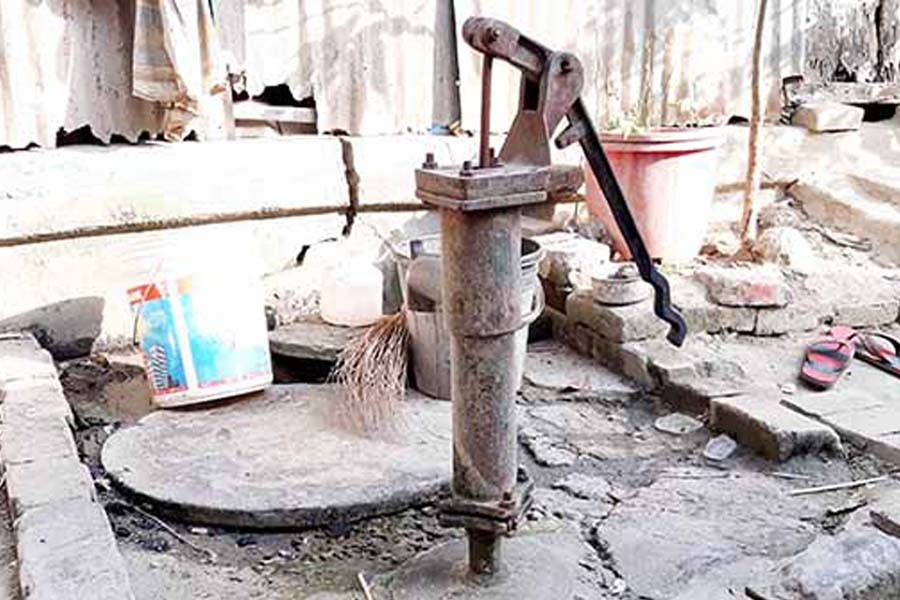
PABNA, Apr 22: Rapid fall in the groundwater level is intensifying water crisis much to the suffering of the commoners in most of the upazilas of Pabna district and the town as well.
Most of the pumps and tube-wells in these areas were already unable to lift water before the onset of summer this year.
Their sufferings have mounted further hampering household chores and business activities.
Official sources attributed the crisis mainly to absence of expected rainfall, filling of many ponds and reservoirs, construction of multi-storey buildings and installation of unplanned submersible pumps.
The groundwater level in Pabna had been falling for the past several years. But this year, before the onset of summer, the level started to drop more rapidly from early February which turned more severe in the middle of April.
Pabna municipality Assistant Engineer Obaid-ul Haque said the water situation is getting worse this year than other years in the town.
He added the manual tube-wells cannot lift water in the municipal area if the water level falls below 20 feet. If the level falls below 22 to 25 feet, it becomes impossible to raise water even with a motor (ordinary pump) in a house.
He said there are 20 deep tube-wells in Pabna municipality area. Although these tube-wells have pipes up to 90 feet deep, water cannot flow.
Apart from this, operation of full tara tube-wells, semi tara tube-wells and shallow tube-wells has completely stopped. Therefore, he fears that the crisis may intensify if there is no heavy rainfall immediately.
The engineer also said that underground water level drops every year at this time and the crisis will be more acute in the future.
According to Pabna BADC office, there are 521 deep tube-wells, shallow tube-wells, LLP tube- wells and solar powered tube-wells in operation for irrigation purpose.
BADC Irrigation Department officials said due to insufficient rain, the groundwater level has started to decline much earlier this year.
At present the water level in the irrigation pump area under the BADC Irrigation Department is still good.
They said that if the drought situation continues like this and if the water level goes down further, it will be difficult to extract water by using these devices.
Apart from these, there are 927 deep tube-wells, 20,592 shallow tub- wells, 1,057 LLP tube-wells under the DAE.
According to the Department of Public Health Engineering, when the water level generally falls below 22 to 25 feet, it becomes difficult to get water from tube-wells in Pabna town and rural areas. But this year, the water level has dropped to 35-38 feet in nine upazilas of the district. That is why most of the tube-wells are not getting water.
Md. Atiqul Islam, executive engineer of Public Health Engineering Department in Pabra, said that the water layer has been decreasing for the past few years. In order to resolve the crisis, the DPHE at the upazila level has given instructions to ensure supply of water through submersible pumps. He said that there are 25,349 deep and shallow tube-wells in the district.
Pabna Barind Multipurpose Development Authority (BMDA) has 14 solar pumps and 73 deep tube-wells. Officials said that there is a problem about water withdrawal from the underground in some places.
Momtazul Islam, a resident of Narayanpur in Pabna town, said that water cannot be lifted through tube-well in the neighbourhood for the past 15 days.
"After pressing for half an hour, even if a little water does not come---. That's why I am forced to fetch water from neighbour's submersible pump," he added.
Mokaram Hossain of Shalgaria area of the town echoed the same. He said that for the past few weeks, almost 90 per cent of the tube-wells in their area were not getting water.
Depletion of groundwater has increased the burden to irrigate Boro plantations. Especially those who are doing irrigation work with sallow machines are in trouble.
Farmer Swapan Kumar Biswas of Khudra Matiabari village of Sadan upazila said that most of the sallow machines in their area were having difficulty in collecting water.
Even if water rises, the amount is very scanty. He claimed that due to the situation, the cost of irrigation is increasing. He added adequate water is needed at this moment for Boro paddy cultivation.
According to the Sujanagar Public Health Engineering Department office and locals, there are about 70,000 manual shallow tube-wells in 10 unions of the upazila including Sujanagar municipality. The average water level in the upazila is 40 to 70 feet deep. Water level has dropped unusually in most areas.
Salma Khatun, a resident of Char Khalilpur village under Sagarkandi union of the upazila, said, "Tube-wells are far away, now it is difficult to get water even from electric water pumps. Since the onset of summer, water in the hand-operated tube-wells is not rising as before."
Abdus Shukur of the area said that fields, roads, canals and riverbanks were baking in the scorching heat. As the ponds and reservoirs have dried up, various villages of the upazila are crying for clean water.
© 2024 - All Rights with The Financial Express
